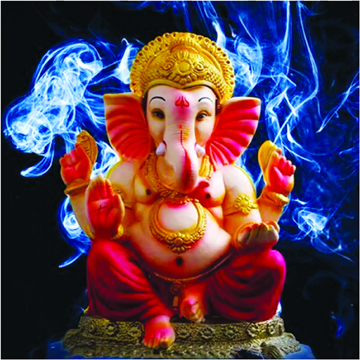
Ganesha Jayanti is celebrated to mark the birth anniversary of Lord Ganesha. As per the Hindu calendar, it is observed on Shukla Chaturthi during Magha lunar month. Ganesha Jayanti is observed in Maharashtra and coastal regions of Konkan during Magha month. In most parts of India, Lord Ganesha’s birth anniversary is observed during Bhadrapada month, known as Ganesha Chaturthi.
As per Drik Panchang, it is Ganesha Jayanti during Magha month which is considered the birth anniversary of Lord Ganesha. In Maharashtra, Ganesha Jayanti is also known as Magha Shukla Chaturthi Varad Chaturthi and Tilkund Chaturthi.
To mark the auspicious occasion, devotees tend to observe a day-long fast and offer prayers to Lord Ganesha to seek wisdom. Just like Ganesh Chaturthi, many worshippers also install idols of the Lord Ganesha in their homes to seek prosperity. Lord Ganesha, who is also known as Vighnharta, the remover of all obstacles, is also offered sweets including Modak which is deemed to be his favourite.
History and significance
Ganesh Jayanti differs from the more popularly celebrated festival of Ganesh Chatuthi which is celebrated across India in the Hindu month of Bhadrapada (August/September). According to some traditions, Ganesh Chaturthi is also considered the birthday of Lord Ganesh.
Ancient customs dictate that on the occasion of Ganesh Jayanti, devotees are prohibited to look at the moon as it supposedly brings the viewer bad luck and suffering. If any person accidentally views the moon on this day, they have to observe a fast for the rest of the day and offer prayers to Lord Ganesh.
Legend has it that on this day, Chandra Dev, the Moon God, mocked Lord Ganesh’s appearance and teased him about his elephant’s head. Chandra Dev also boasted about his own good looks, which greatly angered Lord Ganesh and led him to curse Chandra Dev. Lord Ganesh told him that from that moment on no one would be able to witness the beauty that Chandra Dev so egotistically boasted of.
Shamed by his behaviour and fearful of the curse, the Moon God begged for mercy. Lord Ganesh then said that it would be impossible for him to take the curse back, but he could alter it. Lord Ganesh instructed Chandra Dev that from that point on, he will have to wax for 15 days and wane for the other 15, ensuring that the moon could only be witnessed in its complete glory for a short time.
Celebrations
In order to celebrate the auspicious occasion, devotees observe a day-long fast and offer prayers to the God of wisdom. Some even bring in new and adorned idols of Lord Ganesh into their home to ensure the prosperity of themselves and their family. Lord Ganesh, who is also known as the remover of obstacles is offered red cloth and sweets. Devotees as the Lord to remove any obstacles from their lives and allow them to follow Lord Ganesh in the path of the light.
On the festival day, an image of Ganesha, in symbolic conical form is made out of turmeric or sindhoor powder or some times of cowdung and worshipped. It is later immersed in water on the fourth day after the festival. A special preparation made of til (sesame seeds) is offered to Ganesha and then distributed to the devotees as prasad for eating. A fast is observed during worship during the day time followed by feasting in the night as a part of the rituals.
In addition to fasting on this day, before observing the puja rites for Ganesha (also known as “Vinayaka”), devotees take bath with water mixed with til seeds, after smearing a paste made out of til (sesame) on their body. The fast observed on this day is stated to enhance the name and fame of the individual.
Even though Ganesha is considered a celibate god in Uttar Pradesh (in other places, he is considered as “married”), but on the occasion of the Ganesh Jayanti celebrations, couples worship him to beget a son.
On Ganesh Jayanti, devotees flock to the Moreshwar temple in Morgaon, Pune district, Maharashtra – in large numbers. The temple is starting and ending point of a pilgrimage of eight revered Ganesha temples called Ashtavinayaka. Legend has it that Ganesha killed demon Kamlasur at this place, riding a peacock (in Sanskrit, a mayura, in Marathi – mora) and thus is known as Mayureshwar or Moreshwar (“Lord of the peacock”). Another temple on the Ashtavinayak circuit is the Siddhivinayaka temple at Siddhatek, Ahmednagar district, Maharashtra. Large crowds visit the temple on the occasion of Ganesh Jayanti. This ancient temple located on the eastern bank of the Bhima River – has an idol of Ganesha, seated in a crossed leg posture flanked by his consort Siddhi. The Ganesha image is adorned with saffron paste and has its trunk turned to the right, which is considered a rare depiction. Thus, it is held in deep reverence and a strict set of religious vows are observed to please the deity. Devotees take a pradakhsina (circumambulation) of the hill seven times in the rough hilly terrain to seek favour of Ganesha. Legend states that god Vishnu invoked the blessings of Ganesha at this venue before killing the demons Madhu-Kaitabh to put an end to their depredations.
On the Konkan Coast, at Ganpatipule, a beach temple houses a swayambhu (self-manifest) idol of Ganesha, which is much venerated and visited by thousands of devotees every year. The Ganesha deified in this temple is popularly known as the Paschim Dwardevta (“Western sentinel god of India”). Ganesh Jayanti is also celebrated at this Konkan coastal temple.
Shri Aniruddha House of Friends, Mumbai, India also celebrates Maaghi Ganesh Utsav (celebrations) every year on Ganesh Jayanti. Lord Ganesh is believed to activate and operationalize eight important centres in our body representing each Ashtavinayak (8 sanctums of Lord Ganesha) for which thousands of devotees across India participate in Maaghi Ganesh Utsav and take blessings of Shree Brahmanaspati (Lord Ganesh’s name as mentioned in Rigveda) and Shree Ashtavinayak.





Be the first to comment